Kurt Gänzl
Encylopedia of the Musical Theatre
1 January, 2001
A burlesque of Longfellow’s poem of the same name, the extravaganza Evangeline followed the trials and tribulations of its heroine (Ione Burke) and her beloved Gabriel (Connie Thompson) following their eviction from their sweetly peaceful native village by the beastly British. The show in three acts by J. Cheever Goodwin and with music by Edward E. Rice (“assisted by John J. Braham”) premiered at New York’s Niblo’s Garden on 27 July, 1874.
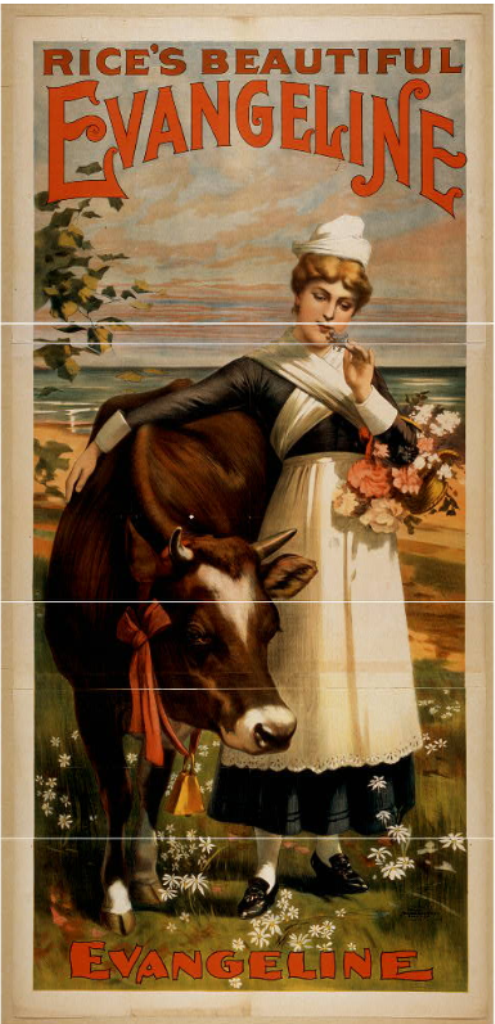
Poster for Edward E. Rice’s “Evangeline” showing the heroine with the famous dancing heifer (Photo: Library of Congress)
The burlesque version allowed the heroine to travel to and through some of the more colourful parts of the world, including darkest Africa and the wildish West, which had not been on the itinerary of her prototype, but which were helpfully and theatrically colourful.
On the way she met some creatures whom Longfellow had not quite imagined either – a dancing heifer (a blatant pinch from Lydia Thompson’s dancing donkey in Forty Thieves), an amorous whale and, above all, the silent but eloquent and ubiquitous Lone Fisherman – whose performances became favourite highlights of the piece.
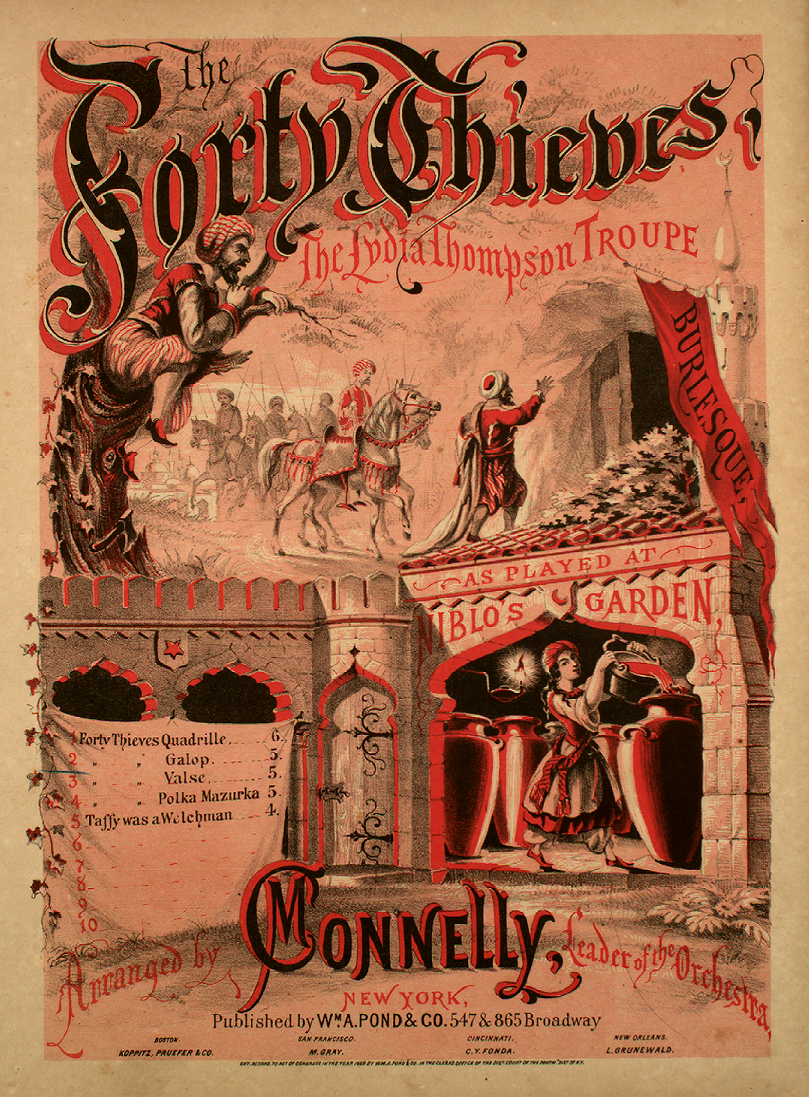
Sheet music cover for Lydia Thompson’s “Forty Thieves” of 1868 which had a dancing donkey.
In keeping with the piece’s burlesque nature, the chief low-comedy rôle of Catherine was played in travesty by Louis Mestayer. A future star in W. H. Crane was the original Leblanc, W. B. Cahill of Lydia Thompson blondes fame was amongst the supporting cast, and the Lone Fisherman was created by pantomimist J. W. Thoman.
Rice’s bulging score included numbers of every shape and size. Ballads and sentimental songs were prominent (‘Thinking, Love, of Thee’, the jaunty ‘Sweet Evangeline’, the waltz ‘He says I Must Go’, ‘Sweet the Song of the Birds’, ‘Come Back to the Heart that is Thine’, ‘Where art thou now my beloved?’, ‘The Kissing Song’, ‘Go Not Happy Day’, the heroine’s ‘Wouldst Know the Way?’ etc.) alongside the comical ‘I Lofe you’, the martial ‘A Hundred Years Ago’, the tale of Sammy Smug’, a bathing trio, a soldiers’ chorus, a dance for the heifer and even a chorus which nodded its recognition to ‘Longfellow’.
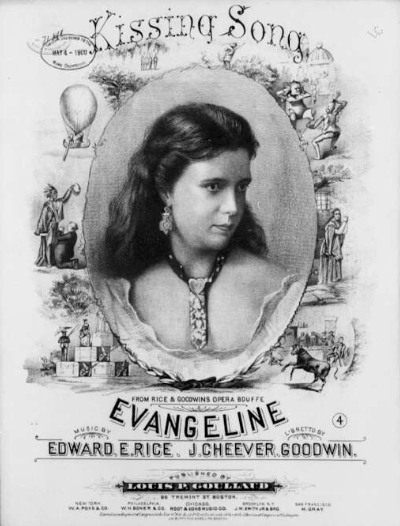
The “Kissing Song” from “Evangeline.” (Photo: Library of Congress)
The piece was apparently given some kind of a trial run in Rice’s hometown of Cambridge, Mass., in 1873, and the young songwriter previewed some of his songs in concert and amongst his clubland cronies in Boston, but Evangeline got its official première in New York as played by the Niblo’s stock company, in a semi-vanity production in which the company were paid by the authors.

Niblo’s Garden in New York, at the corner of Prince Street and Broadway. It was demolished in 1895.
Dully directed, it was dismissed after 16 performances ‘to fair audiences’ in favour of a spectacular drama. However, Rice persisted, and the following season he dipped into his pocket again and organized a revised, revamped and richly decorated version of his show at Boston’s Globe Theatre (5 July 1875), directed by Lydia Thompson’s former chief comic Harry Beckett, with the young English contralto Laura Joyce (Evangeline), Ella Morant (Gabriel) and the well-known pantomimist James Maffit in a built up (by him) but still wholly mimed rôle as the Fisherman.
It played four weeks and closed. The following summer, however, R. M. Field took the production up and ‘considerably cut and pruned, with a number of changes which are decided improvements’, with ‘several new bits of music’, with Lillian Conway (Evangeline) and ex-Lydia Thompson blonde, Eliza Weathersby (Gabriel) featured, and with ‘three acts, twelve sets, quite a number of tableaux, several original sensations, situations and effects’ played it as a summer show at the Boston Museum (15 July 1876).
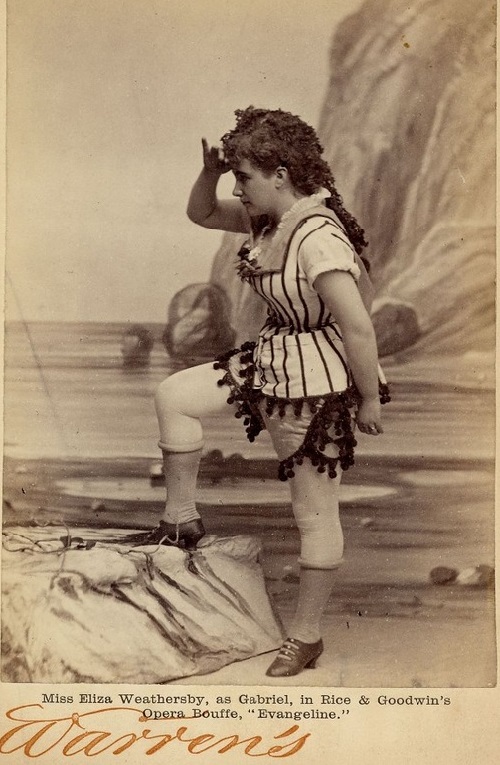
Eliza Weathersby as Gabriel in “Evangeline.”
The show was kept ‘fresh’ with new songs, actors and variety runs being popped weekly into its loose fabric, and this time it ran for five weeks after which Rice sent it touring. Annis Montague (later to be an Australian operatic institution) and Kitty Blanchard headed the cast.
The road proved friendly to the picturesque remake with its patriotic trimmings (‘the first American opéra-bouffe…’, ‘…the marching of the Centennial Fusileers to the song ‘A Hundred Years Ago’) – and in the summer of 1877 the still-touring piece took itself a second turn in the metropolis (Daly’s Theater, 4 June).
It found sufficient friends to stay for a good part of the not-so-fussy summer. The following summer it was again played at the Boston Museum, with Laura Joyce now teamed with Alice Harrison, and bit by persistent bit Evangeline made itself into a familiar favourite, with certain artists such as Maffitt and low comedian George K. Fortescue (Catherine) making themselves synonymous with their rôles as the burlesque toured tirelessly through the seasons and paid several further, brief visits to New York.
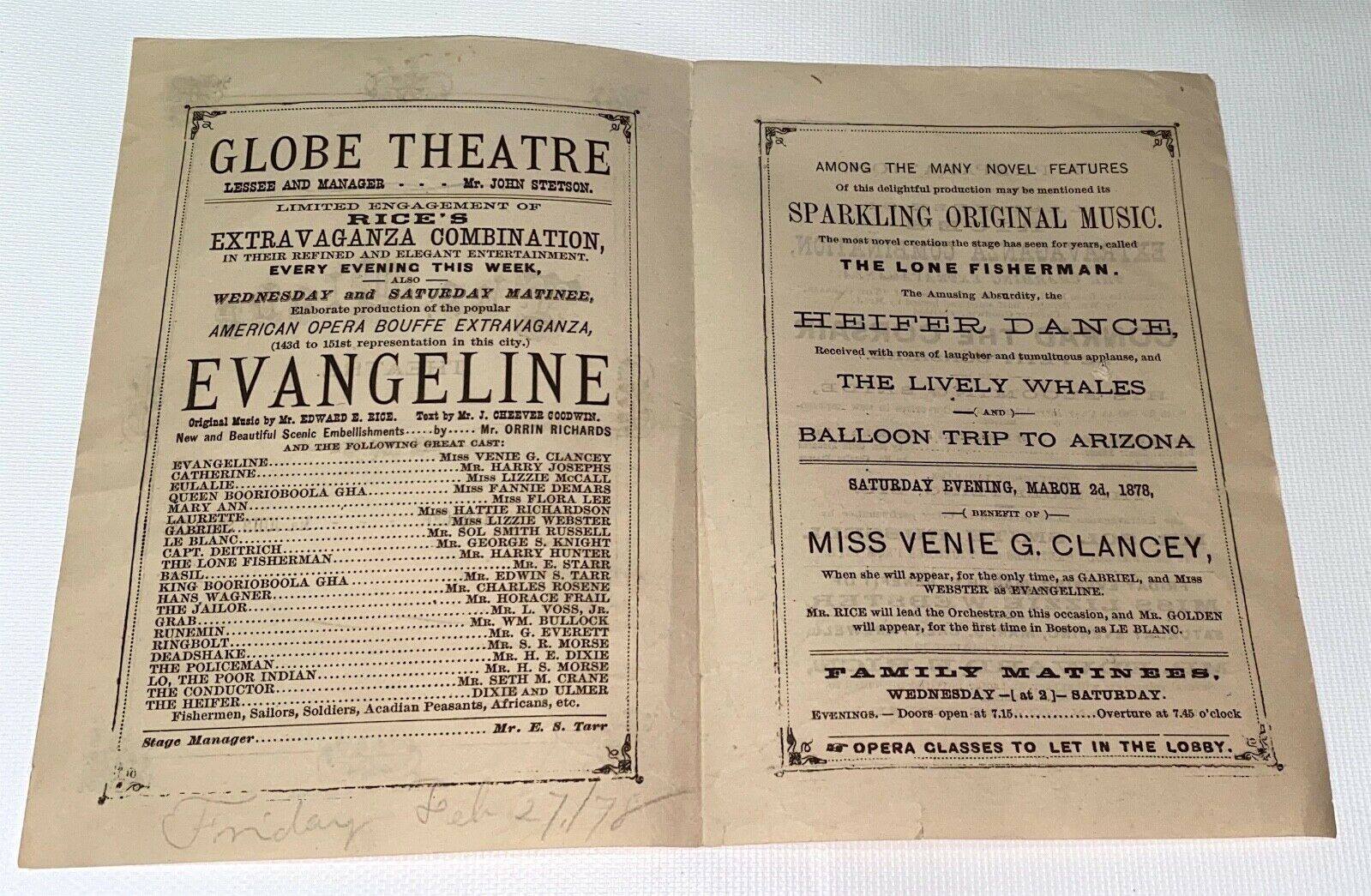
In 1878 Henry E. Dixey got his first stage role playing half a heifer.
It was played a fortnight at the Standard Theater 5 January 1880 and again at Niblo’s Garden shortly after, as The New Evangeline (ad J. J. McNally) for two weeks at Haverley’s 14th Street Theater 30 August 1880 (‘it is called new because some fresh jokes have replaced those that drooped with age and probably a dozen pieces of original music by Mr Rice are added’), at Niblo’s again 3 January 1887 and again at the Star Theater March 1889. It did, however, finally have a genuine Broadway run when, by now a reliable old friend, it was staged at the 14th Street Theater (7 October 1885), with Fay Templeton as Gabriel, for a run of 201 performances.
The show’s touring life took it as far afield as Britain, where M. B. Leavitt’s ‘Rentz-Santley Company’ production appeared at Liverpool, with Nellie Larkelle starred as Gabriel. It did not appeal. Dubbing the evening a ‘wet blanket’ one critic went on: ‘Mere feminine beauty and symmetry can never prove a satisfactory substitute for wit and humour, and as a result Evangeline must be vetoed as not coming within the pale of legitimate stage literature’.
A few weeks later Leeds adjudged ‘it has neither beginning or ending, as far as we could judge, and the entire performance [...] was utterly beneath criticism’. Evangeline did not progress to London. A number of years later, however, it turned up in Australia, played alongside The Corsair in the repertoire of one of Rice’s own companies. Buxom local Fannie Liddiard (Gabriel) and American teenager Virginia Earle (Evangeline) were featured, and a boxing match between Jack, the fighting kangaroo, and the Lone Fisherman introduced as local colour.
It then proceeded on to Tasmania and to South Africa but, although it covered plenty of ground, Evangeline’s real and long-lived success was found wholly in America. In 1896 the piece was produced at Manhattan Beach (June) and subsequently visited Broadway one more time (Garden Theater 1 October) with Theresa Vaughn as Evangeline, Fred Solomon as Le Blanc, Fortescue again as Catherine and Henry E. Dixey as the Lone Fisherman, and in 1901 a major revival was mounted back in Boston (Columbia Theater 14 September) by spectacle merchant David Henderson with Rosemary Gloss (Gabriel) and Frances Burkhardt (Evangeline) featured. It too subsequently went on the road. (For more information on Henry E. Dixey, click here.)
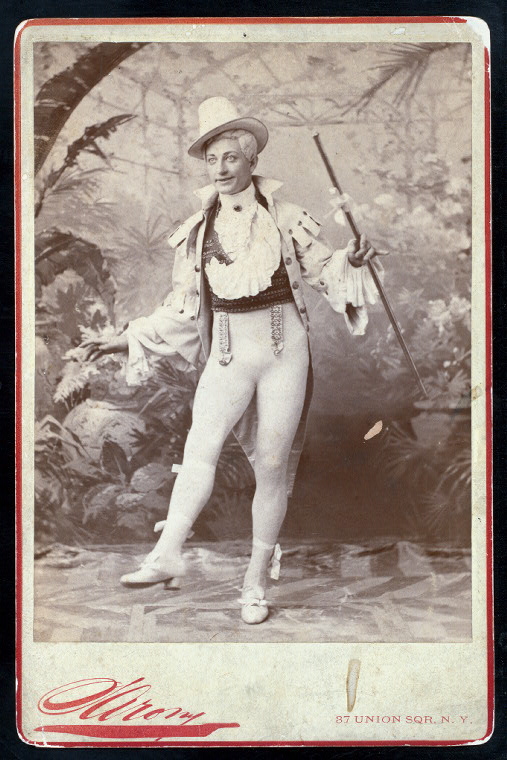
Henry E. Dixey in “Adonis,” 1884, photographed by Sarony.
A staged cantata by the same name, also based on Longfellow’s poem, was composed by Virginia Gabriel and played in London in 1870, whilst an unsuccessful musical version of James Laver’s novel Nymph Errant (George Posford, Harry Jacobson/Eric Maschwitz/Romney Brent), produced with Frances Day in its title-rôle at London’s Cambridge Theatre (14 March 1946), also took the same title.

James Laver’s novel “Nymph Errant.”
In Belgium, Evangeline was a ‘légende canadienne’ by Louis de Gramont and André Alexandre, with music by Xavier Leroux, produced at the Théâtre de la Monnaie in Brussels 28 December 1895.
UK: Court Theatre, Liverpool 11 June 1883; Australia: Opera House, Melbourne 27 April 1891
For an interview with Broadway historian Richard C. Norton on the extravaganzas and burlesques of the 1870s and 80s, click here.
